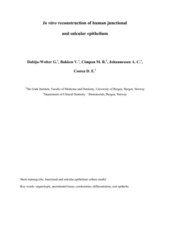In vitro reconstruction of human junctional and sulcular epithelium
Dabija-Wolter, Gabriela; Bakken, Vidar; Cimpan, Mihaela R.; Johannessen, Anne Christine; Costea, Daniela Elena
Journal article
Draft
Permanent lenke
https://hdl.handle.net/1956/6222Utgivelsesdato
2012Metadata
Vis full innførselSamlinger
Originalversjon
https://doi.org/10.1111/jop.12005Sammendrag
Background: The aim of this study was to develop and characterize standardized in vitro three-dimensional organotypic models of human junctional epithelium (JE) and sulcular epithelium (SE). Methods Organotypic models were constructed by growing human normal gingival keratinocytes on top of collagen matrices populated with gingival fibroblasts (GF) or periodontal ligament fibroblasts (PLF). Tissues obtained were harvested at different time points and assessed for epithelial morphology, proliferation (Ki67), expression of JE-specific markers (ODAM and FDC-SP), cytokeratins (CK), transglutaminase, filaggrin, and basement membrane proteins (collagen IV and laminin1). Results: The epithelial component in 3- and 5-day organotypics showed limited differentiation and expressed Ki-67, ODAM, FDC-SP, CK 8, 13, 16, 19, and transglutaminase in a similar fashion to control JE samples. PLF supported better than GF expression of CK19 and suprabasal proliferation, although statistically significant only at day 5. Basement membrane proteins started to be deposited only from day 5. The rate of proliferating cells as well as the percentage of CK19-expressing cells decreased significantly in 7- and 9-day cultures. Day 7 organotypics presented higher number of epithelial cell layers, proliferating cells in suprabasal layers, and CK expression pattern similar to SE. Conclusion: Both time in culture and fibroblast type had impact on epithelial phenotype. Five-day cultures with PLF are suggested as JE models, 7-day cultures with PLF or GF as SE models, while 9-day cultures with GF as gingival epithelium (GE) models. Such standard, reproducible models represent useful tools to study periodontal bacteria–host interactions in vitro.
